Spatial and Temporal Distribution of Pollution Based on Magnetic Analysis of Soil and Atmospheric Dustfall in Baiyin City, Northwestern China
Abstract
:1. Introduction
2. Methods
2.1. Sampling Methods
2.2. Laboratory Measurements
3. Results
3.1. Magnetic Parameters and Their Temporal and Spatial Distribution
3.1.1. Topsoil
3.1.2. Vertical Soil Profiles
3.1.3. Atmospheric Dustfall
3.2. Magnetic Mineralogy
4. Discussion
4.1. Magnetic Properties of Different Environmental Carriers
4.2. Source Allocation of Different Environmental Carriers
5. Conclusions
Author Contributions
Funding
Institutional Review Board Statement
Informed Consent Statement
Data Availability Statement
Conflicts of Interest
References
- Shrey, K.; Suchit, A.; Deepika, D.; Krishnan, S.; Vibha, R. Air pollutants: The key stages in the pathway towards the development of cardiovascular disorders. Environ. Toxicol. Pharmacol. 2011, 31, 1–9. [Google Scholar] [CrossRef] [PubMed]
- Agay-Shay, K.; Friger, M.; Linn, S.; Peled, A.; Amitai, Y.; Peretz, C. Air pollution and congenital heart defects. Environ. Res. 2013, 124, 28–34. [Google Scholar] [CrossRef]
- Wickramasinghe, A.P.; Karunaratne, D.G.G.P.; Sivakanesan, R. PM10-bound polycyclic aromatic hydrocarbons: Biological indicators, lung cancer risk of realistic receptors and ‘source-exposure-effect relationship’ under different source scenarios. Chemosphere 2012, 87, 1381–1387. [Google Scholar] [CrossRef]
- Shang, Y.; Sun, Z.W.; Cao, J.J.; Wang, X.M.; Zhong, L.J.; Bi, X.H.; Li, H.; Liu, W.X.; Zhu, T.; Huang, W. Systematic review of Chinese studies of short-term exposure to air pollution and daily mortality. Environ. Int. 2013, 54, 100–111. [Google Scholar] [CrossRef]
- Abbasi, S.; Keshavarzi, B.; Moore, F.; Hopke, P.K.; Kelly, F.J.; Dominguez, A.O. Elemental and magnetic analyses, source identification, and oxidative potential of airborne, passive, and street dust particles in Asaluyeh County, Iran. Sci. Total Environ. 2020, 707, 136132. [Google Scholar] [CrossRef]
- Hoffman, J.; Stokkaer, I.; Snauwaert, L.; Samson, R. Spatial distribution assessment of particulate matter in an urban street canyon using biomagnetic leaf monitoring of tree crown deposited particles. Environ. Pollut. 2013, 183, 123–132. [Google Scholar] [CrossRef] [PubMed]
- Warrier, A.K.; Shankar, R.; Manjunatha, B.R.; Harshavardhana, B.G. Mineral magnetism of atmospheric dust over southwest coast of India: Impact of anthropogenic activities and implications to public health. J. Appl. Geophys. 2014, 102, 1–9. [Google Scholar] [CrossRef]
- Jones, S.; Richardson, N.; Bennett, M.; Hoon, S.R. The application of magnetic measurements for the characterization of atmospheric particulate pollution within the airport environment. Sci. Total Environ. 2015, 502, 385–390. [Google Scholar] [CrossRef]
- Guda, A.M.; El-Hemaly, I.A.; Abdel, E.M.; Odah, H.; Appel, E.; El Kammar, A.M.; Abu, A.M.; Abu, H.S.; Awad, A. Suitability of magnetic proxies to reflect complex anthropogenic spatial and historical soil heavy metal pollution in the southeast Nile delta. Catena 2020, 191, 104552. [Google Scholar] [CrossRef]
- Hanesch, M.; Scholger, R.; Rey, D. Mapping dust distribution around an industrial site by measuring magnetic parameters of tree leaves. Atmos. Environ. 2003, 37, 5125–5133. [Google Scholar] [CrossRef]
- Canbay, M.; Aydin, A.; Kurtulus, C. Magnetic susceptibility and heavy-metal contamination in topsoils along the Izmit Gulf coastal area and IZAYTAS (Turkey). J. Appl. Geophys. 2010, 70, 46–57. [Google Scholar] [CrossRef]
- Karimi, R.; Ayoubi, S.; Jalalian, A.; Sheikh-Hosseini, A.R.; Afyuni, M. Relationships between magnetic susceptibility and heavy metals in urban topsoils in the arid and semi-arid region of Isfahan, central Iran. J. Appl. Geophys. 2011, 74, 1–7. [Google Scholar] [CrossRef]
- Zhang, C.X.; Appel, E.; Qiao, Q.Q. Heavy metal pollution in farmland irrigated with river water near a steel plant-magnetic and geochemical signature. Geophys. J. Int. 2012, 192, 963–974. [Google Scholar] [CrossRef]
- Qiao, Q.Q.; Huang, B.C.; Zhang, C.X.; Piper, J.D.A.; Pan, Y.P.; Sun, Y. Assessment of heavy metal contamination of dustfall in northern China from integrated chemical and magnetic investigation. Atmos. Environ. 2013, 74, 182–193. [Google Scholar] [CrossRef]
- Wang, B.; Xia, D.S.; Yu, Y.; Jia, J.; Xu, S.J. Detection and differentiation of pollution in urban surface soils using magnetic properties in arid and semi-arid regions of northwestern China. Environ. Pollut. 2014, 184, 335–346. [Google Scholar] [CrossRef]
- Jordanova, D.; Jordanova, N.; Petrov, P. Magnetic susceptibility of road deposited sediments at a national scale-relation to population size and urban pollution. Environ. Pollut. 2014, 189, 239–251. [Google Scholar] [CrossRef] [PubMed]
- Wang, G.; Oldfield, R.; Xia, D.S.; Chen, F.; Liu, X.M. Magnetic properties and correlation with heavy metals in urban street dust: A case study from the city of Lanzhou, China. Atmos. Environ. 2012, 46, 289–298. [Google Scholar] [CrossRef]
- Chen, H.; Wang, B.; Xia, D.S.; Fan, Y.J.; Liu, H.; Tang, Z.R. The influence of roadside trees on the diffusion of road traffic pollutants and their magnetic characteristics in a typical semi-arid urban area of Northwest China. Environ. Pollut. 2019, 252, 1170–1179. [Google Scholar] [CrossRef] [PubMed]
- Zheng, Y.; Zhang, S.H. Magnetic properties of street dust and topsoil in Beijing and its environmental implications. Chin. Sci. Bull. 2008, 53, 408–417. [Google Scholar] [CrossRef]
- Cao, L.W.; Appel, E.; Hu, S.Y.; Yin, G.; Lin, H.; Rösler, W. Magnetic response to air pollution recorded by soil and dust-loaded leaves in a changing industrial environment. Atmos. Environ. 2015, 119, 304–313. [Google Scholar] [CrossRef]
- Wang, B. Magnetic Response of Heavy Metals Pollution of Urban Topsoil in Northwestern China. Ph.D. Dissertation, Lanzhou University, Lanzhou, China, 2014; pp. 1–152. (In Chinese). [Google Scholar]
- Long, Q. Patterns and Magnetic Response to Heavy Metal Pollution along Urban-Rural Gradient, Shanghai. Ph.D. Dissertation, East China Normal University, Shanghai, China, 2013. (In Chinese). [Google Scholar]
- Chen, J.H.; Lu, X.W. The magnetic susceptibility characteristic and its environmental significance of roadside soil in Xi’an city. J. Shanxi Norm. Univ. 2011, 39, 76–82. (In Chinese) [Google Scholar] [CrossRef]
- Maher, B.A. Magnetic properties of some synthetic sub-micron magnetites. Geophys. J. Int. 1988, 94, 83–96. [Google Scholar] [CrossRef]
- Dearing, J.A.; Dann, R.J.L.; Hay, K.L. Frequency-dependent susceptibility measurements of environmental materials. Geophys. J. Int. 1996, 124, 228–240. [Google Scholar] [CrossRef] [Green Version]
- National Bureau of Statistics of the People’s Republic of China. China City Statistical Yearbook; China Statistics Press: Beijing, China, 2014. [Google Scholar]
- Jia, Z.C. Magnetic Studies of Street Dust and Topsoil along Traffic Artery in Shanghai. Master’s Thesis, East China Normal University, Shanghai, China, 2010. (In Chinese). [Google Scholar]
- Lu, S.G.; Bai, S.Q. Magnetic characterization and magnetic mineralogy of the Hangzhou urban soils and its environmental implications. Chin. J. Geophys. 2008, 51, 762–769. (In Chinese) [Google Scholar] [CrossRef]
- Xu, L.; Li, Y.H. Magnetic properties of Urumqi dustfall and its implication to urban pollution. Arid Land Geogr. 2014, 37, 274–280. (In Chinese) [Google Scholar] [CrossRef]
- Li, P.; Qiang, X.K.; Xu, X.W.; Li, X.B.; Sun, Y.F. Magnetic properties of street dust: A case in Xi’an city, Shanxi province, China. Chin. J. Geophys. 2010, 53, 156–163. (In Chinese) [Google Scholar] [CrossRef]
- Zhang, J.H.; Zhang, J.; Wang, X.J.; Wang, J.; Xia, D.S. Magnetic property of dustfall and its environmental significance in Xi’an, China. J. Desert Res. 2015, 35, 699–706. (In Chinese) [Google Scholar] [CrossRef]
- Wang, X.S. Assessment of heavy metal pollution in Xuzhou urban topsoils by magnetic susceptibility measurements. J. Appl. Geophys. 2013, 92, 76–83. [Google Scholar] [CrossRef]
- Wang, B.; Xia, D.; Yu, Y.; Jia, J.; Xu, S. Magnetic records of heavy metal pollution in urban topsoil in Lanzhou, China. Chin. Sci. Bull. 2013, 58, 384–395. [Google Scholar] [CrossRef] [Green Version]
- Xia, D.S.; Chen, F.H.; Bloemendal, J.; Liu, X.M.; Yu, Y.; Yang, L.P. Magnetic properties of urban dustfall in Lanzhou, China, and its environmental implications. Atmos. Environ. 2008, 42, 2198–2207. [Google Scholar] [CrossRef]
- Lu, S.G.; Bai, S.Q.; Xue, Q.F. Magnetic properties as indicators of heavy metals pollution in urban topsoils: A case study from the city of Luoyang, China. Geophys. J. Int. 2007, 171, 568–580. [Google Scholar] [CrossRef] [Green Version]
- Xia, D.S.; Wang, B.; Yu, Y.; Jia, J.; Nie, Y.; Wang, X.; Xu, S.J. Combination of magnetic parameters and heavy metals to discriminate soil-contamination sources in Yinchuan—A typical oasis city of Northwestern China. Sci. Total Environ. 2014, 485–486, 83–92. [Google Scholar] [CrossRef] [PubMed]
- Nie, Y.; Wang, X.; Wang, B.; Xu, S.J.; Gao, F.Y.; Yu, Y.; Xia, D.S.; Xia, X.M. Magnetic responses of Heavy Metals in Street Dust of Typical Mine-Based City, Northwest China. Environ. Sci. 2015, 36, 3438–3446. (In Chinese) [Google Scholar] [CrossRef]
- Evans, M.E.; Heller, F. Environmental Magnetism: Principles and Applications of Enviromagnetics; Academic Press: Burlington, MA, USA, 2003. [Google Scholar]
- Magiera, T.; Zawadzki, J.; Szuszkiewicz, M.; Fabijańczyk, P.; Steinnes, E.; Fabian, K. Impact of an iron mine and a nickel smelter at the Norwegian/Russian border close to the barents sea on surface soil magnetic susceptibility and content of potentially toxic elements. Chemosphere 2018, 195, 48–62. [Google Scholar] [CrossRef] [PubMed]
- Lyberatos, A. Temperature dependence of the magnetization of titanomagnetites. J. Magn. Magn. Mater. 2007, 311, 560–564. [Google Scholar] [CrossRef]
- Dunlop, D.J. Theory and application of the Day plot (Mrs /Ms versus Hcr/Hc) Theoretical curves and test using titanomagnetite data. J. Geophys. Res. 2002, 107, 1–22. [Google Scholar] [CrossRef] [Green Version]
- King, J.; Banerjee, S.K.; Marvin, J.; Özdemir, Ö. A comparison of different magnetic methods of determining the relative grain size of magnetite in natural materials: Some results from lake sediments. Earth Planet Sci. Lett. 1982, 59, 404–419. [Google Scholar] [CrossRef]
- Maher, B.A. The magnetic properties of Quaternary aeolian dust and sediments, and their palaeoclimatic significance. Aeolian Res. 2011, 3, 87–144. [Google Scholar] [CrossRef]
- Maher, B.A. Magnetic properties of modern soils and Quaternary loessic paleosols: Paleoclimatic implications. Palaeogeogr. Palaeocl. Palaeoecol. 1998, 137, 25–54. [Google Scholar] [CrossRef] [Green Version]
- Zawadzki, J.; Fabijańczyk, P.; Magiera, T.; Rachwał, M. Micro-scale spatial correlation ofmagnetic susceptibility in soil profile in forest located in an industrial area. Geoderma 2015, 249–250, 61–68. [Google Scholar] [CrossRef]
- Lourenço, A.M.; Sequeira, E.; Sant’Ovaia, H.; Gomes, C.R. Magnetic, geochemical and pedological characterisation of soil profiles from different environments and geological backgrounds near Coimbra, Portugal. Geoderma 2014, 213, 408–418. [Google Scholar] [CrossRef] [Green Version]
- Shen, M.J.; Hu, S.Y.; Blaha, U.; Yan, H.; Rösler, W. A magnetic study of a polluted soil profile at the Shijingshan industrial area, Western Beijing, China. Chin. J. Geophys. 2006, 49, 1665–1673. [Google Scholar] [CrossRef]
- Flanders, P.J. Collection, measurement and analysis of airborne magnetic particulates from pollution in the environment. J. Appl. Geophys. 1994, 75, 5931–5936. [Google Scholar] [CrossRef]
- Hansard, R.; Maher, B.A.; Kinnersley, R.P. Rapid magnetic biomonitoring and differentiation of atmospheric particulate pollutants at the roadside and around two major industrial sites in the U.K. Environ. Sci. Technol. 2012, 46, 4403–4410. [Google Scholar] [CrossRef]
- Jia, J.; Xia, D.S.; Wei, H.T.; Liu, X.B.; Mao, X.G. Magnetic properties of typical paleosol and loess stratum of western loess plateau and its signification to paleoclimate. J. Lanzhou Univ. 2010, 46, 26–40. [Google Scholar] [CrossRef] [Green Version]
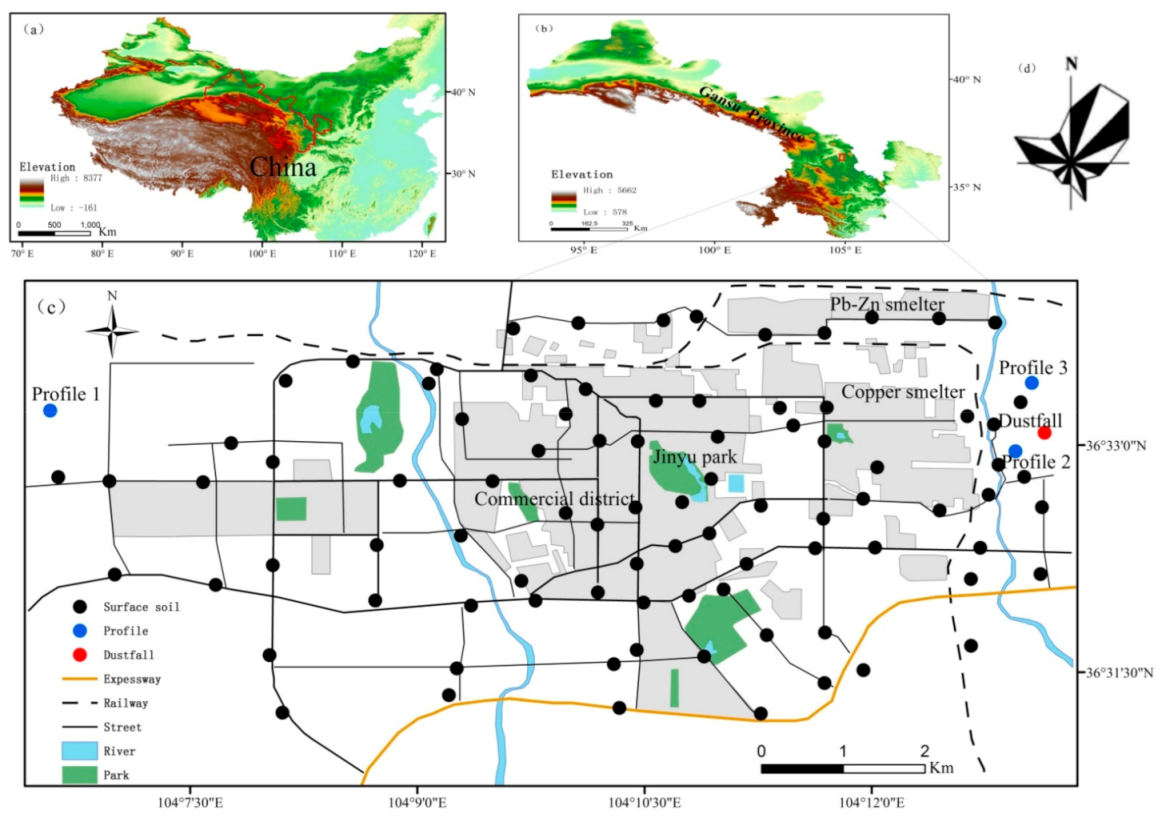
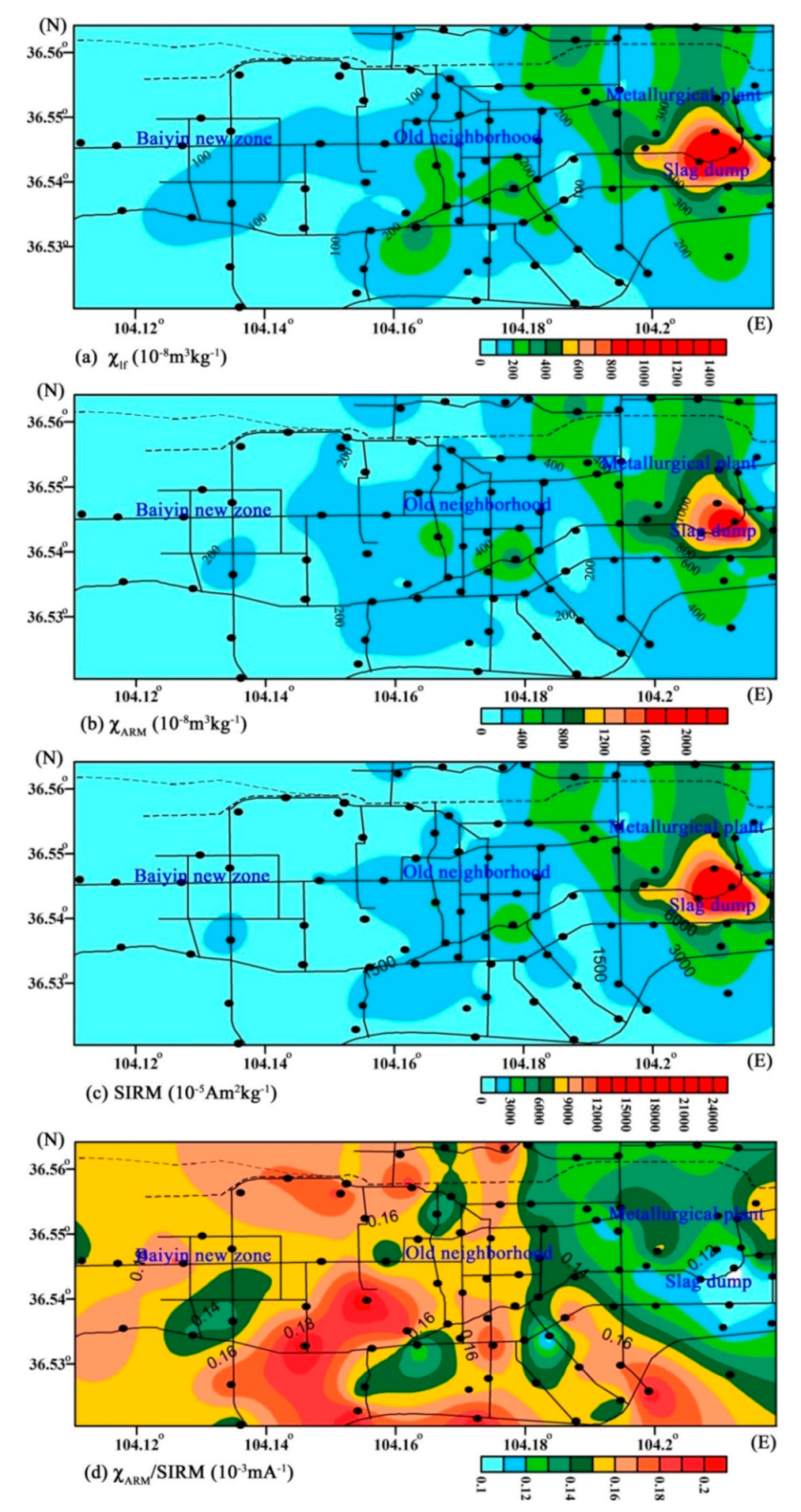
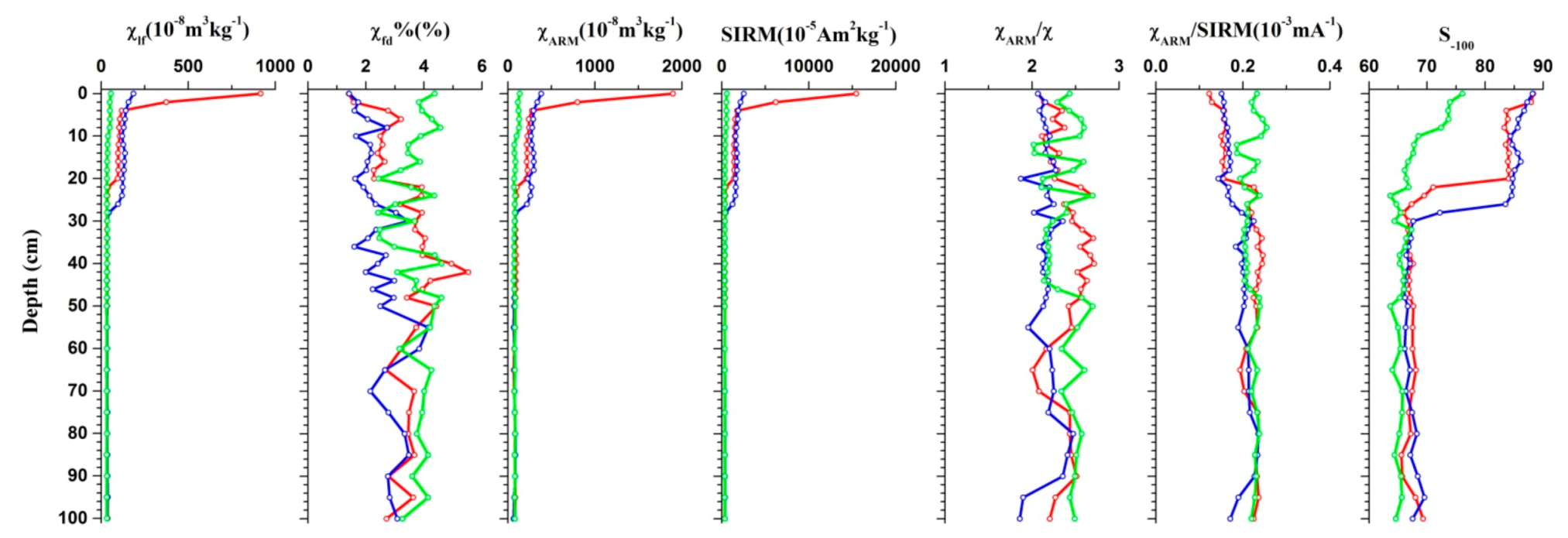



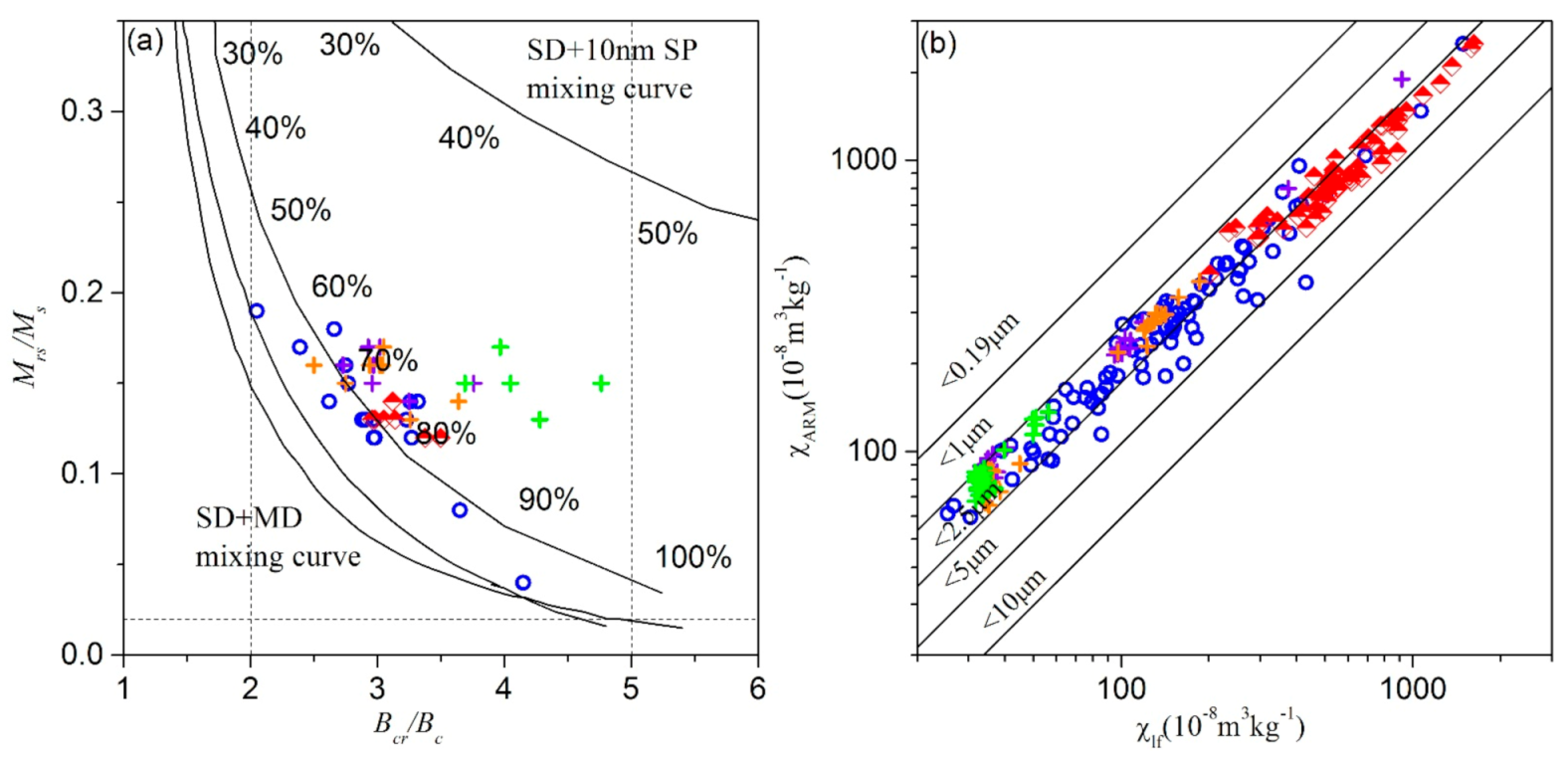
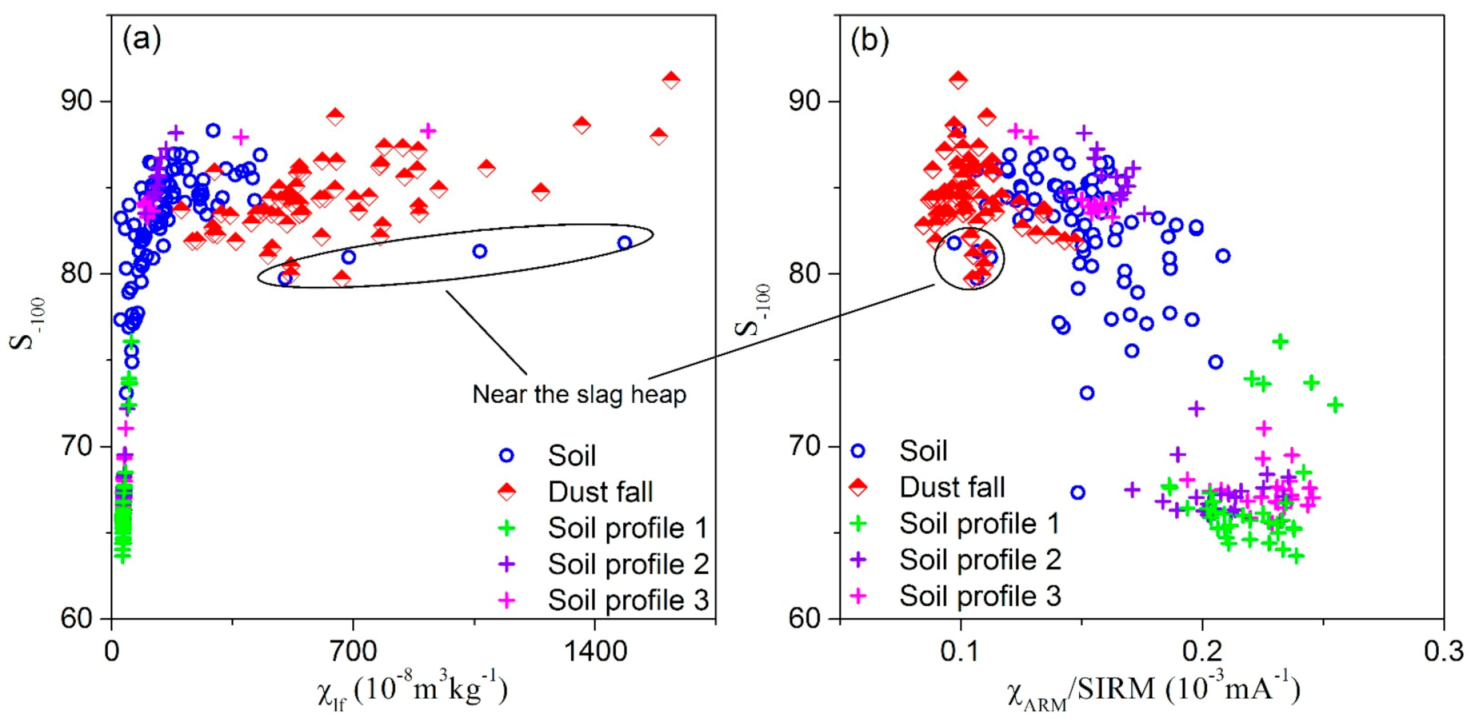
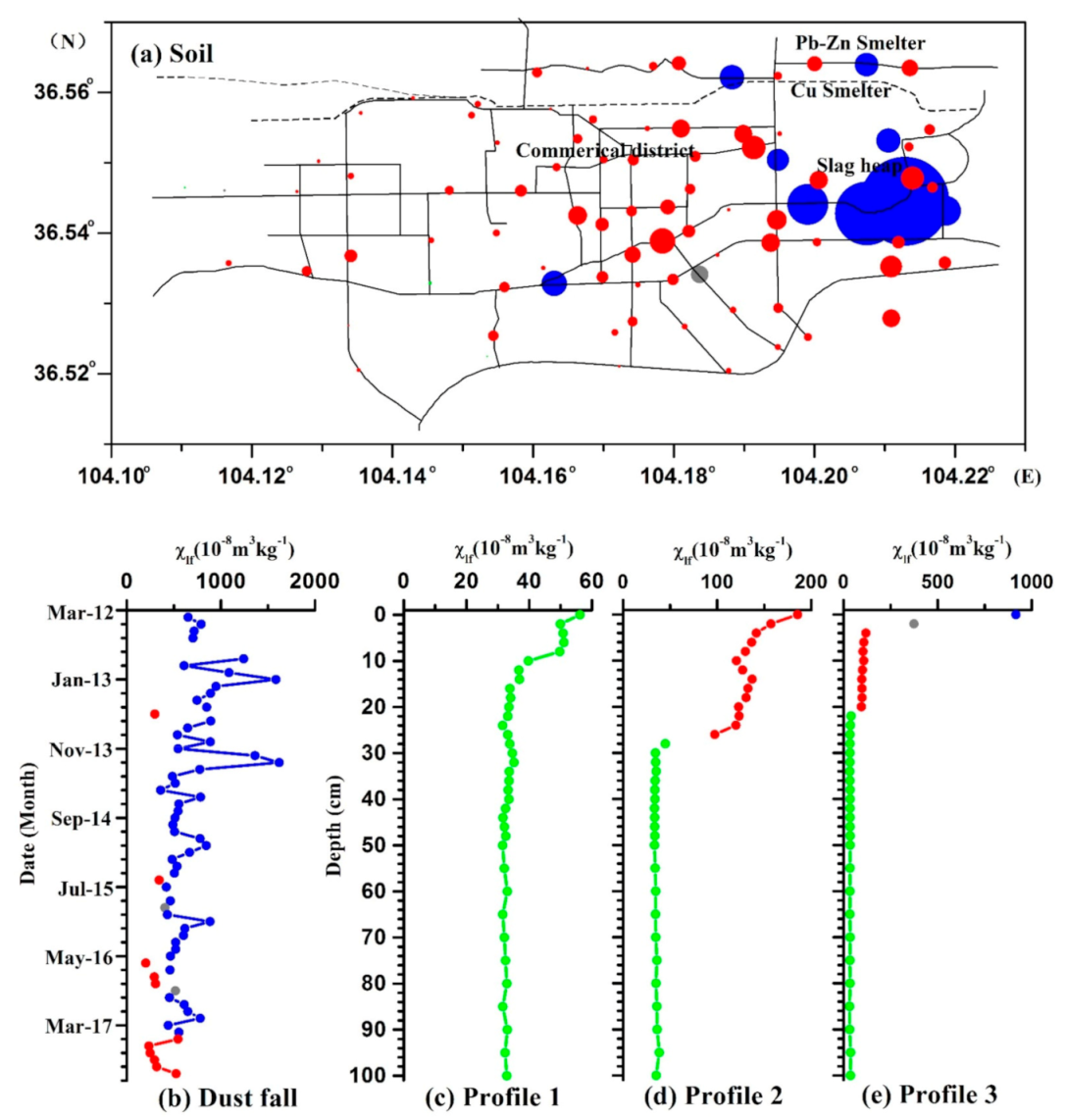
|
χlf (10−8 m3 kg−1) |
χfd% (%) |
χARM (10−8 m3 kg−1) |
SIRM (10−5 Am2 kg−1) | χARM/ χ |
χARM/SIRM (10−3 mA−1) | S−100 | ||
|---|---|---|---|---|---|---|---|---|
| Soil | Mean | 192 | 1.88 | 336 | 2541 | 1.88 | 0.15 | 82.74 |
| Min-Max | 25–1485 | 0.53–3.49 | 60–2509 | 313–25,791 | 0.89–2.70 | 0.10–0.21 | 67.34–88.31 | |
| sd | 207 | 0.66 | 329 | 3259 | 0.34 | 0.02 | 3.52 | |
| CV | 1.08 | 0.35 | 0.98 | 1.28 | 0.18 | 0.16 | 0.04 | |
| Profile 1 | Mean | 36 | 3.70 | 85 | 386.22 | 2.37 | 0.22 | 66.85 |
| Min-Max | 32–56 | 2.42–4.61 | 68–137 | 332–588 | 2.02–2.69 | 0.19–0.25 | 63.67–76.09 | |
| sd | 7 | 0.66 | 20 | 72 | 0.20 | 0.02 | 3.39 | |
| CV | 0.20 | 0.18 | 0.23 | 0.19 | 0.08 | 0.08 | 0.05 | |
| Profile 2 | Mean | 73 | 2.47 | 158 | 912 | 2.16 | 0.19 | 74.36 |
| Min-Max | 33–185 | 1.42–4.15 | 65–383 | 351–2538 | 1.86–2.47 | 0.14–0.24 | 66.06–88.17 | |
| sd | 52 | 0.71 | 110 | 739 | 0.15 | 0.03 | 9.12 | |
| CV | 0.71 | 0.29 | 0.70 | 0.81 | 0.07 | 0.14 | 0.12 | |
| Profile 3 | Mean | 86 | 3.34 | 192 | 1232 | 2.39 | 0.20 | 72.62 |
| Min-Max | 32–916 | 1.41–5.53 | 68–1896 | 345–15,454 | 2.01–2.71 | 0.12–0.25 | 65.57–88.29 | |
| sd | 200 | 0.96 | 411 | 3421 | 0.21 | 0.04 | 8.34 | |
| CV | 2.34 | 0.29 | 2.14 | 2.78 | 0.09 | 0.19 | 0.11 | |
| Atmospheric dustfall | Mean | 625 | 1.00 | 1140 | 9538 | 1.88 | 0.11 | 84.34 |
| Min-Max | 201–1619 | 0.11–2.30 | 407–2504 | 3027–25,308 | 1.21–2.42 | 0.08–0.15 | 79.72–91.23 | |
| sd | 313 | 0.54 | 459 | 4923 | 0.26 | 0.01 | 2.34 | |
| CV | 0.50 | 0.54 | 0.40 | 0.52 | 0.14 | 0.14 | 0.03 |
| City Name | Type | Area of Built Districts/km2 [26] | Population Density (Persons/km2) [26] | Number of Samples |
χlf (10−8 m3 kg−1) |
SIRM (10−5 Am2 kg−1) |
χfd% (%) | Reference |
|---|---|---|---|---|---|---|---|---|
| Beijing | Soil | 1261 | 1006 | 63 | 179 | 1967 | 2.25 | [19] |
| Street dust | 63 | 433 | 4517 | 1.28 | [19] | |||
| Dustfall | 24 | 209 | 6432 | [14] | ||||
| Shanghai | Soil | 886 | 2635 | 97 | 176 | 2421 | 2.47 | [22] |
| Street dust | 439 | 825 | 10,148 | 3.47 | [27] | |||
| Hangzhou | Soil | 453 | 1452 | 182 | 128 | 2562 | 3.60 | [28] |
| Urumqi | Soil | 384 | 263 | 85 | 281 | 2895 | 1.80 | [21] |
| Dustfall | 12 | 509 | 2095 | 2.17 | [29] | |||
| Xi’an | Soil | 375 | 1599 | 34 | 182 | 5.89 | [23] | |
| Street dust | 97 | 530 | 6366 | 4.29 | [30] | |||
| Dustfall | 24 | 357 | 5058 | 2.26 | [31] | |||
| Xuzhou | Soil | 274 | 1056 | 167 | 234 | 2435 | 2.78 | [32] |
| Lanzhou | Soil | 199 | 1265 | 117 | 219 | 2508 | 2.20 | [33] |
| Street dust | 71 | 450 | 6618 | 2.22 | [17] | |||
| Dustfall | 47 | 544 | 9555 | 1.80 | [34] | |||
| Luoyang | Soil | 187 | 3612 | 215 | 236 | 4.32 | [35] | |
| Yinchuan | Soil | 135 | 434 | 75 | 117 | 1519 | 2.00 | [36] |
| Baiyin | Soil | 58 | 141 | 87 | 192 | 2540 | 1.88 | This paper |
| Street dust | 43 | 246 | 3768 | 1.22 | [37] | |||
| Dustfall | 64 | 625 | 9538 | 1.00 | This paper |
|
χlf (10−8 m3 kg−1) |
χfd% (%) |
χARM/SIRM (10−3 mA−1) | S−100 | |
|---|---|---|---|---|
| Cluster 1 | 37 | 3.48 | 0.22 | 67.50 |
| Cluster 2 | 156 | 1.91 | 0.15 | 83.42 |
| Cluster 3 | 663 | 0.96 | 0.10 | 84.28 |
Publisher’s Note: MDPI stays neutral with regard to jurisdictional claims in published maps and institutional affiliations. |
© 2021 by the authors. Licensee MDPI, Basel, Switzerland. This article is an open access article distributed under the terms and conditions of the Creative Commons Attribution (CC BY) license (http://creativecommons.org/licenses/by/4.0/).
Share and Cite
Wang, B.; Zhang, X.; Zhao, Y.; Zhang, M.; Jia, J. Spatial and Temporal Distribution of Pollution Based on Magnetic Analysis of Soil and Atmospheric Dustfall in Baiyin City, Northwestern China. Int. J. Environ. Res. Public Health 2021, 18, 1681. https://doi.org/10.3390/ijerph18041681
Wang B, Zhang X, Zhao Y, Zhang M, Jia J. Spatial and Temporal Distribution of Pollution Based on Magnetic Analysis of Soil and Atmospheric Dustfall in Baiyin City, Northwestern China. International Journal of Environmental Research and Public Health. 2021; 18(4):1681. https://doi.org/10.3390/ijerph18041681
Chicago/Turabian StyleWang, Bo, Xiaochen Zhang, Yuanhao Zhao, Mei Zhang, and Jia Jia. 2021. "Spatial and Temporal Distribution of Pollution Based on Magnetic Analysis of Soil and Atmospheric Dustfall in Baiyin City, Northwestern China" International Journal of Environmental Research and Public Health 18, no. 4: 1681. https://doi.org/10.3390/ijerph18041681




